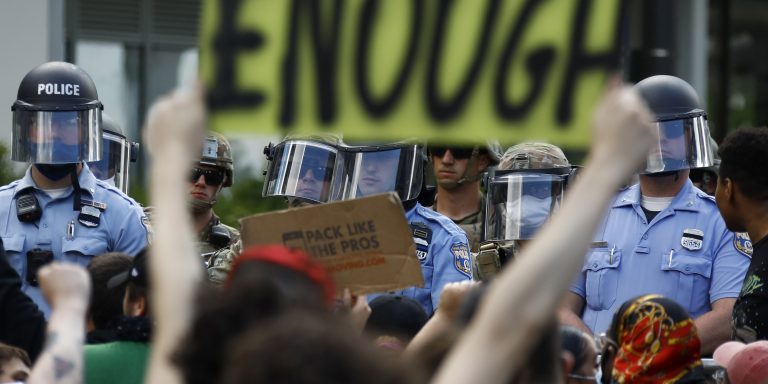INTELBRIEF
June 2, 2020
IntelBrief: Protests Continue to Rage across the United States as Citizens Demand Justice

- The United States continues to be convulsed by violent protests in cities throughout the country in response to the murder of George Floyd, a black man killed during an arrest by Minneapolis police officers.
- A diverse array of actors and agendas have flooded the protest zones, each one of them seeking to either exacerbate or exploit the legitimate protests.
- Cities across the country remain on edge, increasing the chances that miscommunication or heated moments could quickly escalate into deadly violence.
- The protests have further inflamed partisanship, guaranteeing more division and little meaningful action to address the structural factors and legitimate grievances that drove protesters to the streets in the first place—police abuse and criminal misconduct.
The United States continues to be convulsed by violent protests in cities throughout the country in response to the murder of George Floyd, a black man killed during an arrest by Minneapolis police officers. The videos of his death, which showed an officer kneeling on Mr. Floyd’s neck while other officers did nothing, generated intense and understandable outrage at another act of police misconduct and illegal action. What has happened since then has been the inevitable result of generations of police misconduct, a militarization of local police, systemic mistrust in government at all levels, and a society so divided it cannot even agree on basic liberties. Protesters and demonstrators have been intimidated and beaten by police, police officers have been attacked and injured, and there have been several dozen cases reported of violence used by police against journalists. There has been a breakdown of societal norms on multiple levels. Meanwhile, President Trump has failed to address the nation in a meaningful way and instead remains holed up in the White House where he sends a mixture of inflammatory messages and barely cogent single word tweets in all capital letters, including ‘LAW & ORDER,’ ‘CHINA,’ and ‘FAKE NEWS.’ The dearth of leadership is astounding.
A diverse array of actors and agendas have flooded the protest zones, each one of them seeking to either exacerbate or exploit the legitimate protests. From Minneapolis to Atlanta and Philadelphia to New York City, it impossible to accurately categorize and quantify malevolent groups and actors that are among the protesters. But some of these protests have turned violent, with looting, vandalism, and vehicles and businesses being set on fire and destroyed. Extremists from across the ideological spectrum have arrived at these protests to wreak havoc and pursue their own objectives, and in some cases riots have ensued. The objectives of those wreaking violence and havoc are entirely divorced from those seeking justice for George Floyd and African-Americans in the United States, who are demanding police reform and who refuse to remain silent following yet another killing of an unarmed black man. Local and state leaders in Minnesota blamed the violence on outside agitators and those from other states, including criminals and extremists, although it remains unclear exactly what percentage of those arrested were from Minnesota and what percentage were indeed from out of state. Statements by officials say that the riots are engineered and caused by ‘outside agitators’ are true to a limited degree but also misleading because the overwhelming majority of people on the streets are protesters—not rioters—and they are local. Predictably, all nuance and context and proportionality is lost in the sound and fury of riots among the protests.
At various rallies across the country, anarchists destroyed property and spray-painted anarchist symbols on damaged businesses and vehicles. The protests have also led to heavily armed individuals arriving and claiming to want to protect businesses from looters, but also as a bulwark between demonstrators and law enforcement. Opportunists have looted luxury stores in major cities, exploiting the crisis for personal gain and sullying the reason behind the demonstrations. Cities across the country are on edge, increasing the chances that miscommunication or heated moments could quickly escalate into deadly violence. Various states have activated National Guard units to help quell the violence and restore order, but there are reports that the Guard units themselves have become a target of anti-government extremists. Online, the term #boogaloo has been trending with memes and calls for the George Floyd protests as a prelude to the civil war they claim to desire. Accelerationists, a broader category of individuals and groups that believe in hastening the collapse of society, have been active on social media encouraging people to engage in wanton acts of violence.
Politicians are also spinning events to fit their respective narratives. President Trump has predictably framed the protests in partisan terms and dismissed the grievances as artificial; he has boasted about robust law enforcement responses that verge on an eagerness for violence against demonstrators. This issue breaks down along partisan lines – as expected given the deep polarization across the country – guaranteeing more division and little to no meaningful action to address the structural factors that drove protesters to the streets in the first place—police abuse and criminal misconduct. The riots will exacerbate this issue, with police departments and National Guard troops responding to chaotic violence with overwhelming force in a self-destructive feedback loop that the United States seems unable or unwilling to break. The United States continues to struggle with its response to the coronavirus pandemic and is preparing to enter a period of severe economic stress and uncertainty. By almost any indicator, the country seems more fragile now than any point in recent memory. As the November 2020 election approaches, American citizens will demand to hear from politicians how they plan to address issues of police brutality against African-Americans, widespread socio-economic inequality, and a system that seems inherently incapable of addressing the range of issues that matter most to everyday Americans.
.
For tailored research and analysis, please contact: info@thesoufancenter.org